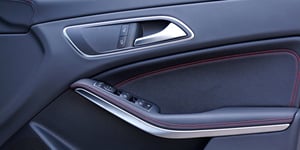Stop me if you’ve been here before.
You’re eight hours into the family road trip. One kid pummels the back of the driver’s seat with their feet while the other demonstrates how loudly they can scream.
You know what would make this situation even more fun? A mysterious and ongoing rattling noise emanating from somewhere in the car.
Strouse has been designing and producing improved sound-dampening parts for years.
Whether you’re looking for soundproofing tips at the personal or professional level, understanding how to designate different areas for soundproofing will allow you to fix them accordingly.
How Does Automotive Soundproofing Work?
Before you begin, it’s essential to recognize that there’s a finite level of noise you can eliminate in a vehicle. Soundproofing and sound dampening are two different concepts, but the words are often used interchangeably when it comes to sound insulation, A.K.A. reducing the noise that comes from your car:
Soundproofing refers to the complete elimination of sound, which often requires materials that are too thick and heavy for an automobile.
You’re likely searching for sound deadening: a method of padding your vehicle's interior to muffle, dampen, and reduce road noise or sound pollution seeping in from the exterior.
Realistically, since car windows are necessary, achieving the identical soundproofing level as a recording studio is impossible. However, with the right strategy, materials, and application, you can still greatly reduce the road noises plaguing you and your passengers.
3 Automotive Soundproofing Issues And How To Fix Them
Whether designing a car or modifying your own for sound insulation, you can get started by assessing your vehicle’s performance (or that of similar vehicles) to determine its problem areas.
If you’re unsure how to find problem areas, you can test the car by driving at varying speeds on different roads and listening carefully for any changes in sound.
In preparation for soundproofing, we will review three potential problems you might encounter during automotive soundproofing and discuss the most common strategies for handling them.
1. ROAD NOISE COMING THROUGH THE FLOOR OR ROOF
As far as I know, nobody loves the intense crunching sound that comes from driving on a gravel road. Even the most hardened drivers can grow irritated when confronted by a wall of sound that detracts from the joy of their favorite tunes.
Many manufacturers have started utilizing sound-dampening methods like adding soundproof mats to the floors and roofs of their vehicles to create thicker barriers between road vibrations and the car’s interior. For instance, the 2023 Honda CRV uses urethane foam inside the pillars and lines the roof with noise and vibration-absorbing material.
Soundproof mats inside cars often have adhesive laminated onto their underside for easy application, but they can also be attached using adhesive tape to create a powerful bond with the surface.
Before securing a soundproof mat, it’s essential to clean the surface to ensure better adhesion. Failing to clean the surface could result in a mat that shifts during movement, and a halfhearted bond could result in even more vibration and noise. Once the mat has been properly installed, it should remain in place and muffle road noise.
2. EVERY BUMP CAUSES A STIR
Life happens, and you might not always be gentle with your car. You could end up driving through potholes or hopping on a back road. Regardless of the terrain you’re driving on, reinforcing your car wheels will preserve the comfort of your passengers in daily circumstances.
Using insulated tires can help reduce vibrations and muffle sounds caused by imperfections in the road.
Tires with additional layers of foam, like an inner tire absorber, built into the surface of the tire tread can prevent vibrations from carrying. Modern noise-canceling tires use polyurethane foam or other specialized materials for acoustic insulation.
Solutions like foam inner tire absorbers might be the perfect fit for manufacturers. There are a variety of different insulated tires on the market, such as the Pirelli noise canceling tires which use polyurethane sponge to reduce half the generated tire noise on average being transmitted to the cabin.
On the other hand, if you’re looking to reduce the noise of your personal vehicle, there could be better sound-dampening choices than specialized tires. Based on the number of cars you’re looking to build/renovate and the cost of materials, you can use your judgment to decide whether custom foam pieces are right for you.
3. NOISE POLLUTION COMING FROM THE DOORS
One of the most popular locations for car soundproofing is the inner panels of the car doors.
You may not realize it, but many cars have insulation built into their interior. The 2021 Rolls-Royce Ghost contained over 100kg of sound-absorbing materials throughout the car in the doors, roof, bulkhead panels, and inside of the tires, making the car so quiet that Rolls-Royce engineers adjusted their design to allow a slight background sound.
Insulating the interior of a car door panel creates another barrier for sound to pass through before it can reach your vehicle's cabin, and it can significantly reduce the amount of ambient sound bleeding through.
These images from 2CarPros show how a car panel comes out, at which point you would attach sheets of sound-insulating material inside the hard interior of the door to create an additional barrier against outside noise.
How To Prevent Automotive Soundproofing Issues in the Future
Keeping a vehicle well-maintained will do the most to prevent long-term rattling or squeaking issues. However, automotive soundproofing has a range of different insulating applications to explore through trial and error.
For instance, it might not be enough to only use rubber mats or thick foam in your car’s interior; rather, you might need a mix of both to cover the entire surface of the problem areas you’re targeting.
In addition, different vehicles will benefit from various combinations of materials. Certain automobiles are uniquely shaped and benefit greatly from customized pieces, so if your automotive design is unique, you may want sound-deadening materials on the interior in a particular size, width, and material.
Do you have a plan for a part that could help you prevent automotive soundproofing issues? Our engineers can evaluate it for part manufacturability:







